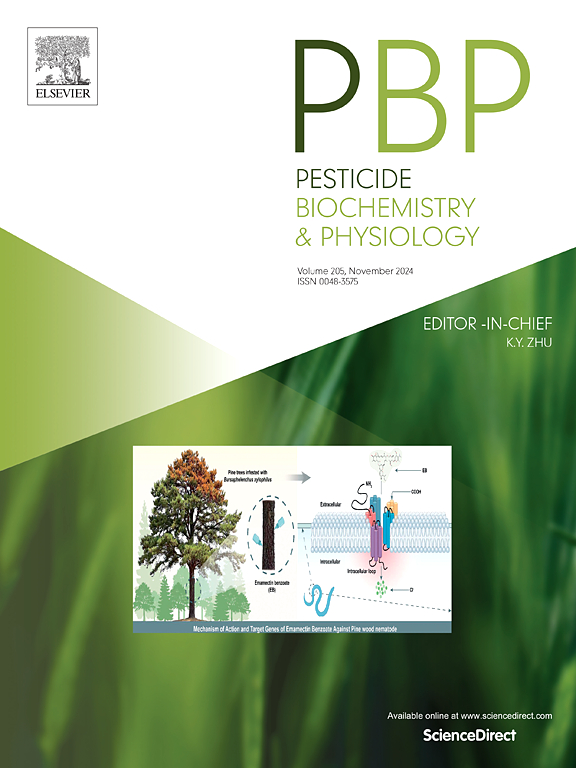p450介导抗性的功能和结构:Cyp6g1和Cyp6g2在果蝇新烟碱代谢中的作用
IF 4.2
1区 农林科学
Q2 BIOCHEMISTRY & MOLECULAR BIOLOGY
引用次数: 0
摘要
杀虫剂驱动的选择压力加速了昆虫种群的进化和抗性的广泛出现。这种抗性的主要机制是杀虫剂的代谢解毒增强,通常由细胞色素P450酶的过度表达或活性增加介导。有证据表明,这些酶赋予耐药性的能力可能是从它们在代谢环境外源物中的天然作用进化而来的。这表明昆虫种群可能拥有多种能够赋予抗性的代谢酶,即使不是专门适应杀虫剂代谢的酶。为了验证这一假说,我们检测了黑腹果蝇的抗性基因Cyp6g1和5个密切相关的细胞色素p450。利用Accord启动子驱动的转基因过表达,我们发现只有Cyp6g1和Cyp6g2对新烟碱类吡虫啉和尼苯吡喃具有抗性。代谢试验证实,吡虫啉抗性是由吡虫啉转化为5-羟基吡虫啉介导的。此外,研究还发现,促进Cyp6g1过表达的田间抗性单倍型也会增加Cyp6g2的表达,这表明Cyp6g2有助于自然群体的抗性。利用分子对接和定点诱变技术对CYP6G1进行结构分析,发现残基Phe123和Phe124对吡虫啉代谢至关重要。这些发现有助于我们理解导致代谢抗性的进化途径,并为改善管理和减轻杀虫剂抗性的策略提供见解。本文章由计算机程序翻译,如有差异,请以英文原文为准。
Functional and structural insights into P450-mediated resistance: The role of Cyp6g1 and Cyp6g2 in the metabolism of neonicotinoids in Drosophila melanogaster
Insecticide-driven selection pressures have accelerated the evolution and widespread emergence of resistance in insect populations. A major mechanism underlying this resistance is the enhanced metabolic detoxification of insecticides, often mediated by the overexpression or increased activity of cytochrome P450 enzymes. Evidence indicates that the ability of these enzymes to confer resistance may have evolved from their native role in metabolising environmental xenobiotics. This suggests that insect populations may harbor multiple metabolic enzymes capable of conferring resistance, even if not specifically adapted for insecticide metabolism. To investigate this hypothesis, we examined the well-characterised resistance gene Cyp6g1 and five closely related cytochrome P450s in Drosophila melanogaster. Using transgenic overexpression driven by the Accord promoter—responsible for elevated Cyp6g1 expression in natural populations—we found that only Cyp6g1 and Cyp6g2 conferred resistance to the neonicotinoids imidacloprid and nitenpyram. Metabolic assays confirmed that imidacloprid resistance was mediated by the conversion of imidacloprid into 5-hydroxyimidacloprid. Additionally, field-resistant haplotypes promoting Cyp6g1 overexpression were also found to increase Cyp6g2 expression, suggesting that Cyp6g2 contributes to resistance in natural populations. Structural analysis of CYP6G1, using molecular docking and site-directed mutagenesis, identified residues Phe123 and Phe124 as critical for imidacloprid metabolism. These findings contribute to our understanding of the evolutionary pathways leading to metabolic resistance and offer insights that could improve strategies for managing and mitigating insecticide resistance.
求助全文
通过发布文献求助,成功后即可免费获取论文全文。
去求助
来源期刊
CiteScore
7.00
自引率
8.50%
发文量
238
审稿时长
4.2 months
期刊介绍:
Pesticide Biochemistry and Physiology publishes original scientific articles pertaining to the mode of action of plant protection agents such as insecticides, fungicides, herbicides, and similar compounds, including nonlethal pest control agents, biosynthesis of pheromones, hormones, and plant resistance agents. Manuscripts may include a biochemical, physiological, or molecular study for an understanding of comparative toxicology or selective toxicity of both target and nontarget organisms. Particular interest will be given to studies on the molecular biology of pest control, toxicology, and pesticide resistance.
Research Areas Emphasized Include the Biochemistry and Physiology of:
• Comparative toxicity
• Mode of action
• Pathophysiology
• Plant growth regulators
• Resistance
• Other effects of pesticides on both parasites and hosts.

 求助内容:
求助内容: 应助结果提醒方式:
应助结果提醒方式:


